Louison Bobet: First three time TDF winner
 Mon, June 10, 2019
Mon, June 10, 2019  When French cyclist Louison Bobet won the Tour de France in 1953, 1954, and 1955 he became the first rider to win the event three consecutive times. His victories came through sheer hard work and determination.
When French cyclist Louison Bobet won the Tour de France in 1953, 1954, and 1955 he became the first rider to win the event three consecutive times. His victories came through sheer hard work and determination.
For example, his first Tour de France was in 1947 at the tender age of 22 he was forced to quit when the race reached the mountain stages. He found the going too tough, and it was a lesson the young Bobet would not forget. He trained even harder and became one of the greatest climbers of his era.
The following year 1948 he was the darling of the French press when he took the Yellow Jersey early in the race. However, that was the year when Italian Gino Bartali was unstoppable and came out a clear winner. (Picture below: Bobet leads Bartali.)

Bobet failed to finish the Tour in 1949, but in 1950 had his best showing to date, finishing 3rd. overall, and taking the King of the Mountains Trophy. However, this showing was somewhat tainted because the entire Italian team quit due to hostility and interference from French spectators. This was when Italian rider Fiorenzo Magni was leading the race. Swiss rider Ferdi Kubler won that year.
Naturally the French Nation expected great things of Louison Bobet the following year 1951. His year began well, Bobet won the Mountains Jersey in the Giro d’Italia. He also won two of the Classic races that year, the Milan – San Remo, and the Tour of Lombardy.
However, his showing in the Tour de France was disappointing when he placed 20th. The French press were writing him off as being a good single day rider, but not having the right stuff to win the Tour. Bobet would miss the 1952 Tour due to injury.
 In 1953 TDF Louison Bobet finally silenced his critics, and for the years that followed he became the favorite of the French Nation. 1947 winner Jean Robic took an early lead, but a crash and an all out attack by the French National Team put Robic out of the race. Louison Bobet, took the yellow jersey on the famed stage over the Izoard Pass and kept it.
In 1953 TDF Louison Bobet finally silenced his critics, and for the years that followed he became the favorite of the French Nation. 1947 winner Jean Robic took an early lead, but a crash and an all out attack by the French National Team put Robic out of the race. Louison Bobet, took the yellow jersey on the famed stage over the Izoard Pass and kept it.
In the 1954 Tour, the Swiss team led by Ferdi Kubler, Hugo Koblet and Fritz Schaer kept up constant pressure. However, as in 1953, Bobet slaughtered his rivals on the Izoard climb and cemented his second consecutive Tour victory.
For some the famed Izoard climb is synonymous with Louison Bobet. The mythic Alpine climb was crucial to his first two Tour victories. So convincing was he in 1954, he left his Swiss rival Ferdi Kubler trailing by twelve minutes.

In 1955, suffering from a saddle sore, many were pessimistic about the chances of Louison Bobet winning his third consecutive Tour de France. Young Luxembourg climber Charly Gaul (Pictured above with Bobet.) grabbed plenty of headlines by winning Bobet's sacred stage to Briançon. But Bobet bounced back by destroying his competition on the feared Mount Ventoux after a long solo victory. It proved to be the key to his third Tour victory.
Bobet's victory on the Mount Ventoux was of the stuff that becomes legendary in Tour history. At the start of the stage, Bobet is still more than 11 minutes down to the unheralded Antonin Rolland. At the foot of the 21-kilometer climb, the Swiss champ attacked with Raphäel Geminiani and no one could follow. (Bobet and Geminiani picture below.)
 However, the Swiss misjudged the difficulty of the climb and faded badly. Bobet, who understood the true menace of the famed mountain, bided his time. In the final six kilometers, above the tree line in under the blazing sun, Bobet caught and passed the leaders. No one could match his driving pace. At the summit Kubler was already 20 minutes down and by the finish in Avignon, Bobet was alone.
However, the Swiss misjudged the difficulty of the climb and faded badly. Bobet, who understood the true menace of the famed mountain, bided his time. In the final six kilometers, above the tree line in under the blazing sun, Bobet caught and passed the leaders. No one could match his driving pace. At the summit Kubler was already 20 minutes down and by the finish in Avignon, Bobet was alone.
By his own admission Bobet was never the same after the 1955 Tour. However, he did win the Paris-Roubaix Classic in 1956. He had placed 3rd in 1955, and had previously placed 2nd in 1951. Louison Bobet won the World Championship Road Race in 1954, was 2nd in 1957 and 1958.
Bobet’s career was effectively ended in December 1961 when his car skidded off the road and hit a boulder. Bobet broke his femur and his recovery was long and difficult. He eventually raced again, but retired the next year at the end of 1962.
Born 1925, Louison Bobet died of cancer in 1983 at the young age of 58. After his death, there was speculation that the saddle sore that had plagued him in his last Tour win, was much more than a simple boil, and may have been cancer. In the 1950s cancer was a taboo subject and no one talked of it. If that was the case, his win showed the sheer guts and determination of the man.

Bobet’s Tour victories came between Fausto Coppi (Above leading Bobet.) and Jacques Anquetil, both men spoke highly of him. Coppi once said of Bobet. “He knows like nobody else how to suffer and his powers of recovery are unmatched. The bike means everything to him. It is truly his life blood and his application to his chosen way of life is an example to every aspiring champion.”

Anquetil (Above 3rd from left, with Bobet leading.) stated “In Bobet’s eyes there were no little races or unimportant victories. Every race mattered and he wanted to give his everything to his public. Bobet knew only one way of racing and that was to race to win, whatever the sacrifices demanded.”
These quotes reflect the respect and admiration of fellow riders and the public. He was certainly one of the heroes of my youth.
First posted March 2009























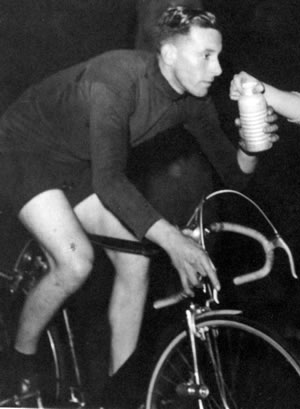
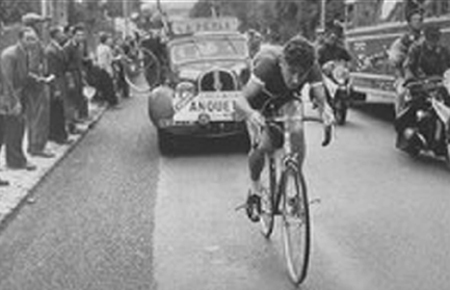

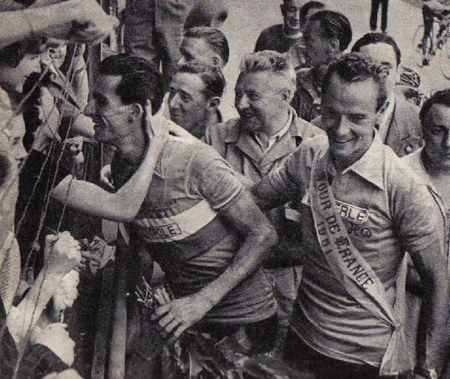 Above: At the finish of the 1951 Tour de France in Paris. Raphael Geminiani (Left.) 2nd. Place, and King of the Mountains. With the winner Swiss rider Hugo Koblet (Right.)
Above: At the finish of the 1951 Tour de France in Paris. Raphael Geminiani (Left.) 2nd. Place, and King of the Mountains. With the winner Swiss rider Hugo Koblet (Right.)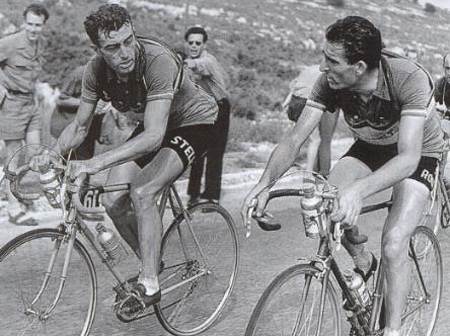
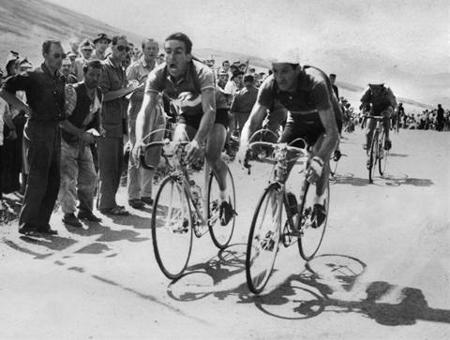 (Above.) Raphael Geminiani narrowly outsprints Italian Gino Bartali to win the 21st stage of the 1952 Tour de France. Alltogether he won seven stages of the TDF between 1949 and 1955 and wore the yellow leader's jersey for four days.
(Above.) Raphael Geminiani narrowly outsprints Italian Gino Bartali to win the 21st stage of the 1952 Tour de France. Alltogether he won seven stages of the TDF between 1949 and 1955 and wore the yellow leader's jersey for four days.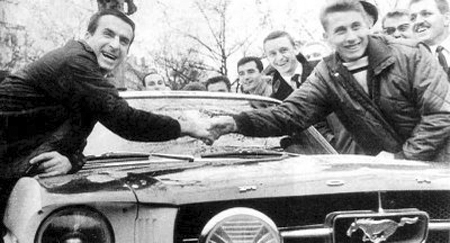 Above: Raphael Geminiani with Jacques Anquetil on the right.
Above: Raphael Geminiani with Jacques Anquetil on the right.
Monday Musings
Get a chair sit down, relax and take it all in. Make sure you have got your fill, because once you kit up and go for the first ride, you need to stop looking at it.
I know anyone with a more than a couple of neurons could figure that one out, but you would be surprised how many people have ridden into parked cars while doing just that. Looking down admiring their bike while riding.
The same goes for after cleaning your bike, or even shaving your legs. It is hard to claim that a parked car pulled out in front of you.
Medical bills and dental work can be extremely expensive, as can bike repairs. So the next time you find yourself glancing down at this beautiful piece of machinery, if only for a spit second, remember this little article, and get your eyes back on the road ahead.
I hope I have just saved someone a whole lot of pain, money and embarrassment.
It was the way I was taught when I first joined a cycling club back in England in the 1950s.
This trend can also be traced all the way back to the invention of the bicycle. The early bicycles only had one brake that operated on the front wheel.
It was a crude device that pressed down directly on the solid rubber front tire.
It had to operate on the front wheel because that was the one closest to the handlebars and the brake lever.
The brake lever was placed on the right because most people are predominantly right handed. So when rear brakes were added, that lever was placed on the left, as everyone was already used to the front brake being on the right.
Also the early brakes were rod operated, cable brakes came later. It made sense for the rear brake operating rods to go on the left side of the frame away from the drive train on the right side. So I am no different from many older English and other European riders, I have always ridden bikes, even as a kid, with the front brake lever on the right, rear brake left.
So why in America is it standard to have the front brake lever on the left? Because in the 1970s when the bike US bike boom started, American bikes were mostly cruisers with rear wheel coaster brakes, and no brake levers were required.
When racing bikes started being imported from Europe, the U S Consumer Protection Agency deemed that all bikes would have the right brake lever operate the rear brake. It is just a government regulation that applies to new bikes. People are free to set their own bike up as they please.
There are many arguments which way is best, but if like me you have been used to a certain set up most of your life, it is probably not wise to switch just for the sake of change.
The design served no useful purpose, but it was a recognition thing, a talking point.
When you saw one go by on the road, you knew it was a Hetchins. Even today people will gather round one and talk about it.
In the 1950s there was a story going round about a group of British riders who went across to France to race. It was in the late 1940s, soon after WWII.
One of the group was riding a Curly Hetchins, and he crashed during the race, rendering himself unconscious. When he came around he found a group of French farm-workers were trying to straighten his bike.
I do know however the Curly Hetchings was a source of amusement to the French.
I remember seeing a Picture of one in Miroir des Sports (But et Club,) a French Cycling Newspaper.
I never did find the full translation of the caption to the picture, but there was a mention of Queen Anne Legs.